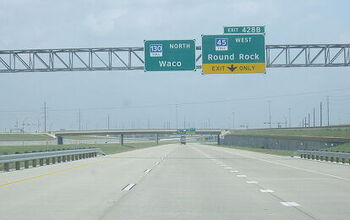Texas Moves to Eliminate Nighttime Speed Limits, Raise Speeds
Texas is the last state in the nation that still imposes different speed limits on its highways depending on whether it is daytime or nighttime. Roads marked 70 MPH during the day can only be legally driven at 65 MPH when its dark. Big rig trucks must also obey specially lowered speed limits. The state House Transportation Committee yesterday filed a favorable report on legislation that would simplify the Lone Star State’s speed laws and boost the speed limit in most rural areas.
“A difference in vehicle speeds can contribute to accidents,” the House committee report explained. “HB 1353 seeks to minimize the number of accidents that can occur when cars and trucks change lanes or pass or tailgate slower-moving vehicles by removing the different, lower speed limit for heavy trucks.”
Instead of a 70 MPH daytime and 65 MPH nighttime maximum speed on rural highways, the default speed limit in all conditions will be 75 MPH. The change would apply to interstate highways, state freeways, farm-to-market and ranch-to-market roads. Only school buses would be forced to adhere to specially lowered limits. The National Motorists Association argues that, contrary to what some might argue, the change will make the roads less dangerous.
“Having split speed limits between cars and trucks sharing the same roadways is poor traffic safety design,” NMA Executive Director Gary Biller the told TheNewspaper. “The same is true for variable daytime/nighttime speed limits. Anything that has the potential for adding driver confusion or uncertainty is inadvisable.”
The Texas Department of Transportation (TxDOT) along with the Utah Department of Transportation, post the fastest legal speed limits of 80 MPH on certain roads. Utah has reported an excellent safety record for its 80 MPH stretch of Interstate 15. Likewise, Texas last year reported a record drop in accidents statewide, with the high-speed roads showing excellent results. After five years of testing, TxDOT also found the 75 MPH limits appropriate for roads outside the urban environment.
“Crash records show that when the speed limit in these areas increased to 75 MPH in 2001, the number of traffic deaths on those segments decreased,” said Carlos Lopez, TxDOT Traffic Operations Division director, in a 2006 department explanation of speed limit changes in West Texas. “Motorists can prevent crashes by practicing safe driving habits.”
If adopted by the full House and Senate, the measure would take effect in September. A copy of the legislation is available in a 53k PDF file at the source link below.
House Bill 1353 (Texas Legislature, 3/30/2011)
[Courtesy: Thenewspaper.com]
More by The Newspaper
Latest Car Reviews
Read moreLatest Product Reviews
Read moreRecent Comments
- Parkave231 Should have changed it to the Polonia!
- Analoggrotto Junior Soprano lol
- GrumpyOldMan The "Junior" name was good enough for the German DKW in 1959-1963:https://en.wikipedia.org/wiki/DKW_Junior
- Philip I love seeing these stories regarding concepts that I have vague memories of from collector magazines, books, etc (usually by the esteemed Richard Langworth who I credit for most of my car history knowledge!!!). On a tangent here, I remember reading Lee Iacocca's autobiography in the late 1980s, and being impressed, though on a second reading, my older and self realized why Henry Ford II must have found him irritating. He took credit for and boasted about everything successful being his alone, and sidestepped anything that was unsuccessful. Although a very interesting about some of the history of the US car industry from the 1950s through the 1980s, one needs to remind oneself of the subjective recounting in this book. Iacocca mentioned Henry II's motto "Never complain; never explain" which is basically the M.O. of the Royal Family, so few heard his side of the story. I first began to question Iacocca's rationale when he calls himself "The Father of the Mustang". He even said how so many people have taken credit for the Mustang that he would hate to be seen in public with the mother. To me, much of the Mustang's success needs to be credited to the DESIGNER Joe Oros. If the car did not have that iconic appearance, it wouldn't have become an icon. Of course accounting (making it affordable), marketing (identifying and understanding the car's market) and engineering (building a car from a Falcon base to meet the cost and marketing goals) were also instrumental, as well as Iacocca's leadership....but truth be told, I don't give him much credit at all. If he did it all, it would have looked as dowdy as a 1980s K-car. He simply did not grasp car style and design like a Bill Mitchell or John Delorean at GM. Hell, in the same book he claims credit for the Brougham era four-door Thunderbird with landau bars (ugh) and putting a "Rolls-Royce grille" on the Continental Mark III. Interesting ideas, but made the cars look chintzy, old-fashioned and pretentious. Dean Martin found them cool as "Matt Helm" in the late 1960s, but he was already well into middle age by then. It's hard not to laugh at these cartoon vehicles.
- Dwford The real crime is not bringing this EV to the US (along with the Jeep Avenger EV)


































Comments
Join the conversation
Some roads I can see that, but most of the FM roads I've driven, even at 65, they are pretty darn entertaining enough to keep me focused.
Wonderful news! Next step -- get rid of the laughably ridiculous speed trap along the .6-mile length of US Highway 287 that runs through Estelline.